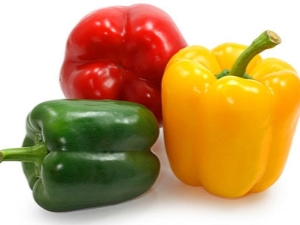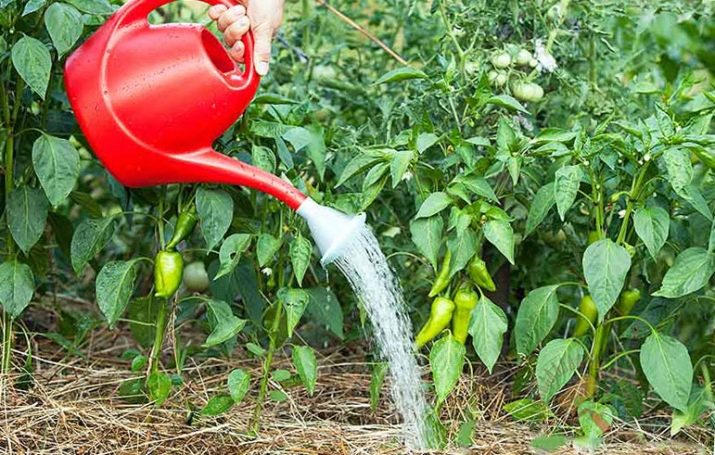What can feed the Bulgarian pepper?

Bulgarian pepper is derived artificially. Breeders have enriched wild vegetables with vitamins, made it tasty.Today, sweet handsome - welcome guest at any table. Pepper dishes are extraordinarily attractive due to its bright colors. Because of the large amount of nutrients contained in the "Bulgarian" vegetable, it is often called the well of health.
Features of culture
Bulgarian pepper belongs to the "capricious" crops. He loves warm and fertile soil, grows poorly on clay and excessively wet soil.
In central Russia, the vegetable is grown through seedlings. Seeds for seedlings sown in warm soil in February, early March. Young shoots require special care, which consists in maintaining the microclimate: light, temperature and humidity.
The seedling grows strong, if the seeds were treated with a nutrient solution, a young young plant was picked at the time, additional lighting was established, and a favorable mode of watering and feeding was ensured.
The pick for the peppers is extremely stressful, so it’s better to immediately place the seeds in a separate cup.
The soil is preferably loose and light. It is possible to independently prepare the soil for seedlings by connecting humus, sand and earth in the proportion of 2/1/1.
The root system develops well in peat-filled pots of small diameter. When planting in the soil is not required to remove the plant from the container, disturb the roots.
If any of the seedlings of the seedlings turned yellow, know that the pepper "speaks" of excess water. Watering should be regular, and the pots should have holes to remove excess water in the tray. Lack of drainage will lead to rotting of the roots and the death of a young plant.
Peppers are planted in unheated greenhouses in May, in open ground - in early June. Before planting, the plants are hardened: in the daytime, they are brought out for several hours outside, of course, when the cold falls, and the air warms up to +10 degrees and above.
Good pepper yield is possible only on prepared soil. Peppers are planted on ridges where onions or carrots, pumpkins or cabbage were grown. With the autumn digging, potash and phosphate fertilizers should be applied to the ground, and in the spring it should be enriched with ammonium nitrate.
Do not rush to fertilize peppers immediately after transplanting to a permanent place. First, fertilizing should be carried out a couple of days before landing on the "permanent residence", and secondly, all the trace elements necessary for the plant should be in the soil itself.
If at this time part of the leaves turn yellow, does not mean that the peppers need help. The change in color of the lower leaves and their death is a natural process.
Fertilizer terms
Pepper loves being cared for and responds to attentiveness. The care consists primarily of dressings. Delayed fertilizer affects growth and fruiting, slowing down both. When the feeding stages are observed, optimal conditions are provided for obtaining a bountiful harvest.
The first feeding goes to seedlings when two true leaves appear on sprouts. The following feeding is carried out for seedlings that develop at home, 14 days after the first. A couple of days before transplanting to a greenhouse or open ground, seedlings should receive another nutrient dose.
The difference in the care of peppers planted in the greenhouse and in the open ground, lies in the timing. Greenhouse plants fall into the ground earlier, therefore, they receive the next batch of fertilizers earlier.
Peppers are transplanted to the open ground at the beginning of June, while they are covered with a covering material, providing good ventilation. In both cases, the plants must be replenished two weeks after planting. During flowering plants need a lot of "food", so the next feeding will help in the formation of ovaries.
During cold spells, especially long ones, the plants are under stress. Often, the superficial roots die off, the peppers have little strength left to continue the development.To restore the fruiting process after cold days, foliar fertilization is required.
Carefully monitor the condition of the bushes. By the color and state of the foliage, it is always possible to determine the need of a plant for a particular element. Twisted leaves indicate a lack of potassium, and unfriendly flowering with good foliage - the need to make superphosphate and the exclusion of nitrogen from regular feeding.
Types and methods
There are two equivalent types of plant nutrition:
- foliar;
- root
In the case of peppers, both are used.
Top dressing is carried out necessarily well soluble substances. Powdered substances are scattered on the ground in the grooves around the plant, granulated dissolve in water and enter the soil during irrigation.
The nutrient solution is absorbed by plants much faster, so it is most often used.
Watering should be done carefully, protecting leaves from falling on them fertilizer intended for root feeding. Fertilizer-enriched droplets can cause burns to the leaves.
Foliar top dressing more time consuming, but no less useful. Adult plants during active flowering and fruiting can be sprayed every one and a half to two weeks. The more fertile the soil, the less frequently foliar dressing is required. Preferably the alternation of both methods of fertilizing peppers.
Folk remedies
Most often gardeners fertilize the land with organic fertilizers:
- peat;
- manure;
- bird droppings;
- humus
Those who do not trust the "shop" products, use folk remedies: yeast, ash, egg shells, iodine, herbal cocktails.
If you feed the peppers with yeast, it is usually a positive effect on their growth and immunity. The yeast is dissolved in warm water with the addition of sugar, insist, then diluted in more water and produce root dressing.
One drop of iodine, dissolved in three liters of water, is able to protect the seedlings from diseases.
With a lack of potassium in the soil around the bushes poured wood ash.
Peppers are useful herbal infusions of weeds, including nettle. Crushed weeds and lawn grass insist for several days, mixed with clean water and watered the plants.
Ready-made purchase options
Ready-made fertilizers contain everything you need for bell peppers. The recipe is selected for both seedlings and adult bushes. The complex fertilizer for Kemira-Lux seedlings has proven itself well.
A strong root system to the peppers provides fertilizer "Crystal", containing a sufficient amount of potassium and phosphorus.
How to make?
Fertilizer can be applied by watering and spraying. In ready-made fertilizers purchased in stores, the dosage and method of feeding are indicated on the packaging. Fertilizers such as superphosphate and urea are soluble in water. Similarly, come with cow dung and bird droppings.
Spraying the bushes with a solution of boric acid contributes to:
- increased ovary formation;
- improve the taste of the fruit;
- increased disease resistance.
When using chemicals do not violate the proportions.
Useful tips
And a few more tips from experienced gardeners and gardeners.
- Before planting peppers you should not richly enrich the earth with organic matter.
- The soil for peppers needs to be prepared in the autumn, and phosphate and potash fertilizers should be added for digging.
- Nitrogen fertilizers are applied to the ground before sowing. Nitrogen contributes to the formation of ovaries, but its excess negatively affects the resistance of plants to disease.
- On the lack of soil phosphorus peppers notify purple leaves.
- A grower must recognize plant signals and provide them with necessary microelements in a timely manner.
Errors when growing bell pepper, see the following video.






























